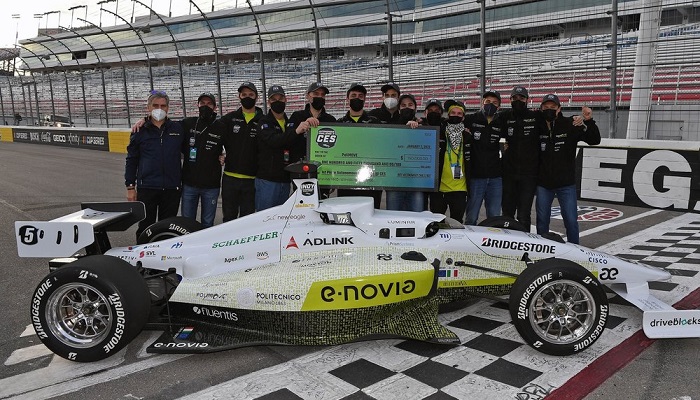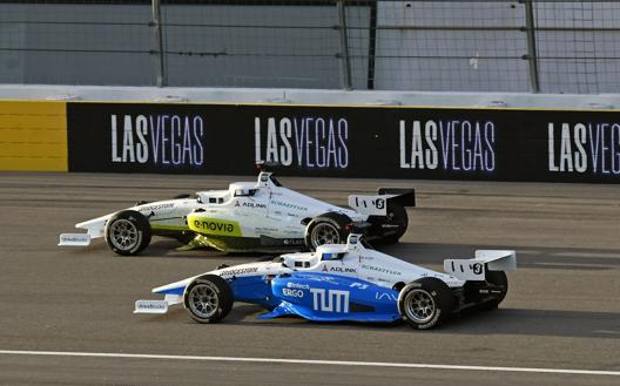In Italy, university sport is traditionally not very popular, but last January 7 something happened that could change this, and 2022 could be remembered as the beginnging of a new sport .
For the uninitiated, the CES - Consumer Electronics Show is the largest trade fair in electronics in the world, held once a year, every January, in Las Vegas, since 1967. There some products that have made history have seen the light, such as the video recorder in 1970. The technologies that pervade our lives are always revealed, well in advance, at CES.
In 2022 the 55th edition was held (from 5 to 8 January). The VCR is a distant memory. We live in a world of artificial intelligence, augmented and hybrid reality, self-driving cars ... A world in which the Polytechnic has a place of honor. During CES, the first head-to-head race between unmanned cars took place on 7 January , the Autonomous Challenge, organized by the Energy Systems Network (the non-profit organization that also launched the Indy Autonomous Challenge ). It involved the running teams of the best universities in the world and it was Italy, with Politecnico di Milano, that won the first prize of 150 thousand euros ( read more here).

The national and international press that is dealing with the subject agrees on this definition.
From around the world

Recap of previous episodes : Team PoliMOVE , led by Professor Sergio Savaresi of the Department of Electronics, Information and Bioengineering of Politecnico di Milano, is a team that this year has won almost everything. The extraordinary results achieved are also the result of the collaboration with e-Novia , which supports the team as main sponsor, Fluentis and Movyon , in as supporting sponsor. The team is also a partner of the University of Alabama.
Between March and October 2021, during tests and qualifying races aboard a virtual car , PoliMOVE dominates the rivals, over 30 university teams from all over the world who have participated in the Indy Autonomous Challenge (a bit the "prequel" of the race on 7 January). On 23 October, the teams take to the track with real cars for the final .
The cars used for the race are Dallara AV-21 cars , the most advanced self-driving racing cars in existence. All the same, for all teams . What changes is only the "pilot" driving, the artificial intelligence. Our car has a name and (in the intentions of the programmers) a face: AS.CAR.I. (acronym for AutonomouS CAR Intelligence) , in homage to the great Italian driver.
On October 23 AS.CAR.I. missed gold by a hair , due to a breakdown in the car that sends him off the track, however, winning the championship speed record: 252 km/h. The Dallaras are indeed the most advanced self-driving cars in the world, but they are not yet perfect : " The engine broke down when we reached maximum speed, ”explains Savaresi, who at the moment doesn't know exactly what happened. In first place, the German team TUM, of the Technical University of Munich.
The same fault limits the results of PoliMOVE also in December 2021, during a solo race carried out to beat the absolute speed record for an autonomous vehicle . AS.CAR.I. makes it for a very short time: with 283.18 km / h, or 175.96 mph, it surpasses Roborace's speed record (175.49 mph) recorded by the Guinness and UK Timing Association in 2019. Watch the video of the record: World's Fastest Autonomous Racecar - PoliMOVE Speed Record .

“ We were able to identify the nature of the fault: there was an overcurrent which shut down the engine. All teams would have had the same problem, if another team's car had reached that speed, it would have shut down like ours. We were going too fast for her. We finally understood where the problem was and the organizers have, on our indication, removed it in time for the new race of 7 January 2022 “.
This time, a real head-to-head competition : while in Indianapolis the cars took to the track one at a time (to limit the difficulty coefficient of such a new and unpredictable competition) at the Autonomous Challenge @ CES final we see the first head-to-head in history between artificial pilots at those speeds , once again PoliMOVE in the final against the Germans of TUM. A challenge with overtaking strokes, in which the polytechnic team triumphs in the end:
"A milestone in the history of autonomous driving: two cars launched at 280 km per hour , almost touching each other. But this time they didn't manage to keep up with us ”, comments a beaming Savaresi after the victory.
This glorious year for Politecnico is almost at the end: the last step, in a few weeks, will be the attempt to break the world record again.
“We aim for 200 mph, 320/330 km / h ”. What about next year? "Triplets: first in the simulation race, first at Indy and first at CES", jokes Savaresi, but he knows that, in sport, victory is not sung too soon: "Seriously, it is important to remain among the first, then sometimes you win, sometimes you lose. What is certain is that we can no longer hide: we are the ones to beat ". A few numbers: the car costs 600,000 euros, of which 300,000 are subsidized by ESN and 300,000 through sponsors and donations. In addition to out-of-pocket travel costs, not counting the research grants of the PhD students in the team, about thirty automation, computer, electronic, telecommunication and mechanical engineers. “You have to do it right. We need a budget of 1 million euros per year ".
"In general, motorsport has always had the function of anticipating automotive technologies," explains Savaresi, becoming serious again after the emotion. "Futuristic solutions are tried on the track, perhaps a little dangerous, which can also fail, are tested in a controlled context with limited risk, and then the experience is transferred to production cars. All car technologies have passed from motorsport : engine development, aerodynamics, materials, etc. All, except automatic checks . Artificial intelligence (the one that gave rise to ABS, traction control, stability control ...) is systematically banned by the federations because it detracts from the role of the driver. For this reason, there is a huge gap between F1 technology, the highest expression of motorsport, and production cars: the latter are much more refined . But the autonomous car is the keystone of a revolution that will affect the world of mobility over the next 10-15 years, forever changing the way we travel (but also how we live). This revolution requires a major technological leap: the development of a completely autonomous car. Therefore, we need a field of experimentation ".
This is the meaning of the birth of a new sport, autonomous motorsport. Which could one day lead to a confrontation between a flesh-and-blood Ascari and an artificial one:
“ In the future I imagine a championship in which man and machine will compete . In 10 years, perhaps, every F1 team will have an artificially piloted car and a car with a human driver ”.
And who will win? We ask: “Good question. Some say that it will end up like chess, where at a certain point the artificial intelligence has exceeded our computing abilities and from that moment on it has always won. But driving a car isn't like playing a game of chess, it doesn't end in a finite number of combinations. I expect AI to be able to compete with a human pilot in about ten years . Then, it will take another 10-20 years for the machines to overtake us. But, at that point, we must keep in mind that AI has an advantage over us that has nothing to do with the ability to calculate: its ability to perceive the world at 360 ° with a quantity of sensory stimuli that do not we can match with our natural senses. To continue competing, we will develop augmented human : we will equip human pilots with augmented perception. We do not yet know how, but technology will give man a perception comparable to that of the car: at that point the race will be open again. The human and the artificial mind will compete on equal terms ".
You can support this project with a donation. Give now
Credits header: quattroruote.it
Credits home: therobotreport.com